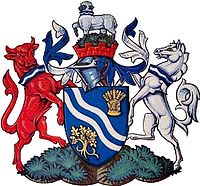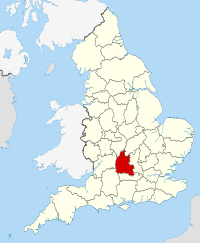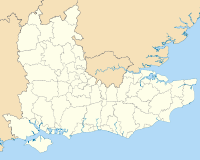- Oxfordshire
-
Oxfordshire 
Coat of arms of Oxfordshire

Flag of OxfordshireMotto of County Council: Sapere Aude ('Dare to be Wise')[1] 
Geography Status Ceremonial & Non-metropolitan county Region South East England Area
- Total
- Admin. councilRanked 22nd
2,605 km2 (1,006 sq mi)
Ranked 19thAdmin HQ Oxford ISO 3166-2 GB-OXF ONS code 38 NUTS 3 UKJ14 Demography Population
- Total ()
- Density
- Admin. councilRanked 35th
648,700
249 /km2 (640 /sq mi)
Ranked 17thEthnicity 95.1% White
1.7% S. AsianPolitics
Oxfordshire County Council
http://www.oxfordshire.gov.ukExecutive Conservative Members of Parliament Districts 
Oxfordshire (
 /ˈɒksfərdʃər/ or /ˈɒksfərdʃɪər/; archaically the County of Oxford; abbreviated Oxon from the Latinised form of "Oxford", Oxonia) is a county in the South East region of England, bordering on Warwickshire and Northamptonshire (to the north/northeast), Buckinghamshire (to the east), Berkshire (to the south), Wiltshire (to the southwest) and Gloucestershire (to the west).
/ˈɒksfərdʃər/ or /ˈɒksfərdʃɪər/; archaically the County of Oxford; abbreviated Oxon from the Latinised form of "Oxford", Oxonia) is a county in the South East region of England, bordering on Warwickshire and Northamptonshire (to the north/northeast), Buckinghamshire (to the east), Berkshire (to the south), Wiltshire (to the southwest) and Gloucestershire (to the west).It is divided into five local government districts: Oxford, Cherwell, Vale of White Horse (after the Uffington White Horse), West Oxfordshire and South Oxfordshire.
The county has a major tourist industry. The area is noted for the concentration of performance motorsport companies and facilities. Oxford University Press is the largest firm among a concentration of print and publishing firms; the University of Oxford is also linked to the concentration of local biotechnology companies.
The main centre of population is the city of Oxford. Other significant settlements are Banbury, Bicester, Kidlington, and Chipping Norton to the north of Oxford; Witney to the west; Thame and Chinnor to the east; and Abingdon, Wantage, Didcot, Wallingford and Henley-on-Thames to the south. Future population growth in the county is hoped[clarification needed] to be concentrated around Oxford, Banbury, Bicester, Didcot and Witney, near the South Midlands growth area.
The highest point of the administrative county is White Horse Hill, in the Vale of White Horse, reaching 261 metres (856 ft).[2] The highest point in the historic county is near Portobello Farm in the Chiltern Hills at 255 metres.
Oxfordshire's county flower is the Snake's-head Fritillary.
Contents
History
Template:Mein
Oxfordshire was formed as a county in the early years of the 10th century and is broadly situated in the land between the River Thames to the south, the Cotswolds to the west, the Chilterns to the east and the Midlands to the north, with spurs running south to Henley-on-Thames and north to Banbury.
Historically the area has always had some importance, since it contains valuable agricultural land in the centre of the county. Ignored by the Romans, it was not until the formation of a settlement at Oxford in the eighth century that the area grew in importance. Alfred the Great was born across the Thames in Wantage in Berkshire. The University of Oxford was founded in 1096, though its collegiate structure did not develop until later on. The university in the county town of Oxford (whose name came from Anglo-Saxon Oxenaford = "ford for oxen") grew in importance during the Middle Ages and early modern period. The area was part of the Cotswolds wool trade from the 13th century, generating much wealth, particularly in the western portions of the county in the Oxfordshire Cotswolds. Morris Motors was founded in Oxford in 1912, bringing heavy industry to an otherwise agricultural county. The importance of agriculture as an employer has declined rapidly in the 20th century though; currently under one percent of the county's population are involved due to high mechanisation.
Throughout most of its history the county was divided into fourteen hundreds, namely Bampton, Banbury, Binfield, Bloxham, Bullingdon, Chadlington, Dorchester, Ewelme, Langtree, Lewknor, Pyrton, Ploughley, Thame and Wootton.
The Oxfordshire and Buckinghamshire Light Infantry, the main army unit in the area, was based at the Barracks on Bullingdon Green, Cowley.
The Vale of the White Horse district and parts of the South Oxfordshire administrative district south of the River Thames were historically part of Berkshire, but were added to the administrative county of Oxfordshire in 1974. Conversely, the Caversham area of Reading was historically part of Oxfordshire as was the parish of Stokenchurch, now administratively in Buckinghamshire.
Economy
This is a chart of trend of regional gross value added of Oxfordshire at current basic prices published (pp. 240–253) by Office for National Statistics with figures in millions of British Pounds Sterling.
Year Regional Gross Value Added[3] Agriculture[4] Industry[5] Services[6] 1995 7,607 120 2,084 5,404 2000 10,594 80 2,661 7,853 2003 12,942 93 2,665 10,184 Education
Oxfordshire has a completely comprehensive education system with 23 independent schools and 35 state schools. The state schools are from the ages of 11 to either 16 or 18. Only eight schools do not have a sixth form; these are mostly in South Oxfordshire and Cherwell districts.
The county has two universities, significantly the University of Oxford and also Oxford Brookes University, both located in Oxford. Oxfordshire also has Wroxton College, located in Banbury, which is affiliated with Fairleigh Dickinson University of New Jersey.
Buildings
The "dreaming spires" of the buildings of the University of Oxford play a large contribution in Oxford being the sixth most visited city in the United Kingdom for international visitors[7]. Notable University buildings include the Sheldonian Theatre, built 1664–1668 to the design of Sir Christopher Wren, and the Radcliffe Camera, built 1737–1749 to the design of James Gibbs.
Blenheim Palace close to Woodstock was built by the great architect John Vanbrugh for John Churchill, 1st Duke of Marlborough, after he had won the battle of Blenheim. The gardens, which can be visited, were designed by the landscape gardener "Capability Brown", who planted the trees in the battle formation of the victorious troops. In the palace, which can also be visited by the public, Sir Winston Churchill was born in 1874.
Chastleton House, on the Gloucestershire and Warwickshire borders, is a great country mansion that was built on property bought from Robert Catesby, who was one of the men involved in the Gunpowder Plot with Guy Fawkes. Stonor Park, another country mansion, has belonged to the recusant Stonor family for centuries.
Mapledurham House is an Elizabethan stately home in the far south-east of the county, close to Reading.
Settlements in Oxfordshire
- Abingdon (In Berkshire until 1974)
- Banbury
- Bicester
- Burford
- Carterton
- Charlbury
- Chipping Norton
- Didcot (In Berkshire until 1974)
- Faringdon (In Berkshire until 1974)
- Henley-on-Thames
- Kidlington
- Oxford
- Thame
- Wallingford (In Berkshire until 1974)
- Wantage (In Berkshire until 1974)
- Watlington
- Witney
- Woodstock
Settlements by population
Rank Town Population Year Definition Notes 1 Oxford 134,248 2001 Oxford non-metropolitan district 155,000 Oxford urban area (Oxford district and Seacourt, Botley and Kidlington). 2 Banbury 41,802 2001 Civil parish 3 Abingdon 30,626 2001 Civil parish 4 Bicester 28,672 2001 Civil parish 5 Witney 22,765 2001 Civil parish 6 Didcot 22,762 2001 Civil parish 200 dwellings in the southeast of the town lie in neighbouring East Hagbourne parish. 7 Kidlington 13,719 2001 Civil parish Does not include Gosford. 8 Carterton 11,805 2001 Civil parish 9 Thame 11,072 2001 Civil parish Includes hamlet of Moreton 10 Henley on Thames 10,646 2001 Civil parish 11 Wantage 9767 2001 Civil parish The northern and western fringes of Wantage, lie across the border in Grove and East Challow respectively. 12 Grove 7845 2001 Civil parish Includes the northern fringes of Wantage. 13 Wallingford 6496 2001 Civil parish 14 Faringdon 6187 2001 Great Faringdon civil parish 15 Chipping Norton 5972 2001 Civil parish 16 Eynsham 4665 2001 Civil parish 17 Benson 4464 2001 Civil parish 18 Wheatley 3905 2001 Civil parish 19 Kennington 3881 2001 Civil parish 20 Sonning Common 3778 2001 Civil parish Places of interest
Main article: List of museums in OxfordshireKey 
Abbey/Priory/Cathedral 
Accessible open space 
Amusement/Theme Park 
Castle 
Country Park 
English Heritage 
Forestry Commission 
Heritage railway 
Historic House 

Museum (free/not free) 
National Trust 
Zoo  Abingdon County Hall Museum[8] – housed in a 17th century County Hall building
Abingdon County Hall Museum[8] – housed in a 17th century County Hall building Ashdown House – 17th century country house in the Lambourn Downs
Ashdown House – 17th century country house in the Lambourn Downs Ashmolean Museum - Oxford University's museum of art and archaeology
Ashmolean Museum - Oxford University's museum of art and archaeology Banbury Museum, Banbury
Banbury Museum, Banbury- Bicester Village
 Blenheim Palace and garden – UNESCO World Heritage Site
Blenheim Palace and garden – UNESCO World Heritage Site Broughton Castle – 14th century fortified manor house
Broughton Castle – 14th century fortified manor house Buscot Park, Buscot – 18th century country house and landscape garden
Buscot Park, Buscot – 18th century country house and landscape garden Champs Chapel Museum of East Hendred – village museum in a 15th century Carthusian chapel
Champs Chapel Museum of East Hendred – village museum in a 15th century Carthusian chapel Charlbury Museum
Charlbury Museum Chastleton House – 17th century country house (limited access)
Chastleton House – 17th century country house (limited access) Chiltern Hills – Area of Outstanding Natural Beauty
Chiltern Hills – Area of Outstanding Natural Beauty Chinnor & Princes Risborough Railway – operated with steam and diesel locomotives
Chinnor & Princes Risborough Railway – operated with steam and diesel locomotives Chipping Norton Museum [1]
Chipping Norton Museum [1] Cholsey and Wallingford Railway
Cholsey and Wallingford Railway Cogges Manor Farm Museum, Witney – a living museum of country life
Cogges Manor Farm Museum, Witney – a living museum of country life Combe Mill Museum,[2] Long Hanborough – working museum of stationary steam engines
Combe Mill Museum,[2] Long Hanborough – working museum of stationary steam engines Cotswold Wildlife Park and garden, Bradwell Grove, Holwell
Cotswold Wildlife Park and garden, Bradwell Grove, Holwell Cotswolds – Area of Outstanding Natural Beauty
Cotswolds – Area of Outstanding Natural Beauty Didcot Railway Centre – museum of the Great Western Railway
Didcot Railway Centre – museum of the Great Western Railway Dorchester Abbey, Dorchester-on-Thames – 12th century church of former Augustinian abbey
Dorchester Abbey, Dorchester-on-Thames – 12th century church of former Augustinian abbey Great Coxwell Barn – 14th century Tithe barn
Great Coxwell Barn – 14th century Tithe barn Greys Court, Rotherfield Greys – 16th century country house
Greys Court, Rotherfield Greys – 16th century country house Hampton Gay Manor – ruins of 16th century manor house (no website)
Hampton Gay Manor – ruins of 16th century manor house (no website)- Harcourt Arboretum, Nuneham Courtenay
 Heythrop Hall – 17th century country house: now a hotel, golf & country club
Heythrop Hall – 17th century country house: now a hotel, golf & country club- Hook Norton Brewery – working Victorian "tower" brewery that offers guided tours
 Kelmscott Manor – Home of William Morris
Kelmscott Manor – Home of William Morris Mapledurham Estate – 16th century country house and 15th century watermill
Mapledurham Estate – 16th century country house and 15th century watermill Milton[disambiguation needed
Milton[disambiguation needed  ] Manor House – 18th century country house [3]
] Manor House – 18th century country house [3] Minster Lovell Hall – dovecote and ruins of 15th century manor house
Minster Lovell Hall – dovecote and ruins of 15th century manor house Museum of Bygones, Claydon – private museum including stationary steam engines
Museum of Bygones, Claydon – private museum including stationary steam engines North Wessex Downs – Area of Outstanding Natural Beauty
North Wessex Downs – Area of Outstanding Natural Beauty


 Oxford
Oxford Oxford Bus Museum and Morris Motors Museum, Long Hanborough
Oxford Bus Museum and Morris Motors Museum, Long Hanborough Oxford Canal – 18th century "narrow" canal
Oxford Canal – 18th century "narrow" canal The Oxfordshire Museum, Woodstock
The Oxfordshire Museum, Woodstock The Ridgeway
The Ridgeway River and Rowing Museum, Henley-on-Thames
River and Rowing Museum, Henley-on-Thames River Thames
River Thames- Rollright Stones – megalithic stone circle and Whispering Knights burial chamber, near Little Rollright
 Rousham House – 17th century country house and landscape garden
Rousham House – 17th century country house and landscape garden- Rycote chapel – 15th century chapel with original furnishings
- St Katharine's church, Chiselhampton – 18th century parish church with original furnishings (no website, limited access)
- St Mary's church, Iffley – 12th century Norman parish church [4]
 Shotover Country Park, Headington
Shotover Country Park, Headington Spiceball Country Park, Banbury
Spiceball Country Park, Banbury Stanton Harcourt manor house (limited access), with garden and 15th century chapel and Pope's Tower (no website)
Stanton Harcourt manor house (limited access), with garden and 15th century chapel and Pope's Tower (no website) Stonor House – country house and 14th century chapel of the recusant Stonor family
Stonor House – country house and 14th century chapel of the recusant Stonor family Swalcliffe Tithe Barn – 15th century
Swalcliffe Tithe Barn – 15th century Thame Museum [5]
Thame Museum [5] Tolsey Museum, Burford (no website)
Tolsey Museum, Burford (no website) Uffington White Horse, Uffington Castle and Wayland's Smithy burial chamber in the White Horse Hills
Uffington White Horse, Uffington Castle and Wayland's Smithy burial chamber in the White Horse Hills Wallingford Museum
Wallingford Museum Wheatley Windmill – 18th century tower mill [6]
Wheatley Windmill – 18th century tower mill [6]
See also
- Lord Lieutenant of Oxfordshire
- High Sheriff of Oxfordshire
- Oxford University (including links to the individual colleges).
- Oxford Canal
References
- ^ "Camelot International, Britain's heritage and history". http://www.camelotintl.com/heritage/counties/england/oxfordshire.html. Retrieved 9 November 2011.
- ^ http://www3.imperial.ac.uk/portal/pls/portallive/docs/1/587934.PDF%7C
- ^ Components may not sum to totals due to rounding
- ^ includes hunting and forestry
- ^ includes energy and construction
- ^ includes financial intermediation services indirectly measured
- ^ http://www.oxford.gov.uk/PageRender/decC/Economic_statistics_occw.htm Oxford City Council – Economic statistics
- ^ Abingdon County Hall Museum website
Further reading
- Philip Powell – The Geology of Oxfordshire (Dovecote Press, 2005) ISBN 1-904349-19-6
External links
- Oxfordshire County Council
- Thisisoxfordshire Oxfordshire news, sport & information
- The Oxfordshire Association
- Flags of Oxfordshire
- Visit South Oxfordshire
- Banbury & District National Trust Association
- Oxfordshire at the Open Directory Project
Neighbouring counties 
Warwickshire Warwickshire, Northamptonshire Northamptonshire 
Gloucestershire 
Buckinghamshire  Oxfordshire
Oxfordshire 

Wiltshire Berkshire Berkshire Ceremonial county of Oxfordshire Oxfordshire Portal Boroughs or districts Major settlements Abingdon • Banbury • Bicester • Burford • Carterton • Charlbury • Chipping Norton • Didcot • Faringdon • Henley-on-Thames • Oxford • Thame • Wallingford • Wantage • Watlington • Witney • Woodstock
See also: List of civil parishes in OxfordshireTopics  Districts of South East England
Districts of South East EnglandBerkshire 
Buckinghamshire Aylesbury Vale • Chiltern • Milton Keynes • South Bucks • Wycombe
East Sussex Brighton and Hove • Eastbourne • Hastings • Lewes • Rother • Wealden
Hampshire Basingstoke and Deane • East Hampshire • Eastleigh • Fareham • Gosport • Hart • Havant • New Forest • Portsmouth • Rushmoor • Southampton • Test Valley • Winchester
Isle of Wight Kent Ashford • Canterbury • Dartford • Dover • Gravesham • Maidstone • Medway • Sevenoaks • Shepway • Swale • Thanet • Tonbridge and Malling • Tunbridge Wells
Oxfordshire Surrey Elmbridge • Epsom and Ewell • Guildford • Mole Valley • Reigate and Banstead • Runnymede • Spelthorne • Surrey Heath • Tandridge • Waverley • Woking
West Sussex Adur • Arun • Chichester • Crawley • Horsham • Mid Sussex • Worthing
Categories:- Oxfordshire
- Non-metropolitan counties
- South East England
Wikimedia Foundation. 2010.
